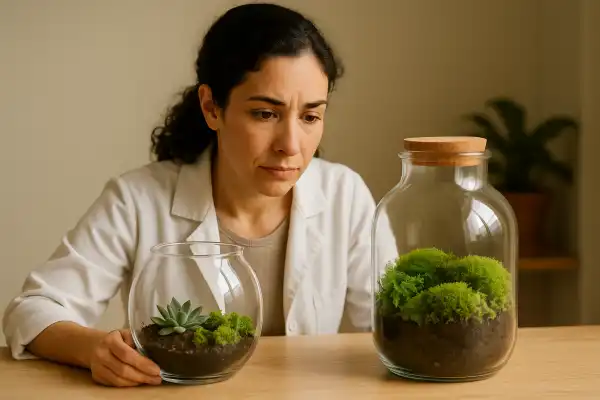Building your first terrarium feels like stepping into the role of a miniature world architect. The question “What is the difference between open vs closed terrarium?” emerges naturally when you’re standing in front of glass containers, wondering which path will lead to the thriving ecosystem you envision.
Understanding these two terrarium types becomes essential because each creates a completely different environment for your plants. The choice between sealed and unsealed containers determines everything from watering schedules to plant selection, shaping the success of your miniature garden from the very beginning.
What is the difference between open vs. closed terrarium?
Open terrariums are glass containers without lids that allow for better air circulation and help prevent buildup of excess moisture, while closed terrariums are sealed with a lid or cover, creating miniature ecosystems where plants produce oxygen and humidity in a self-contained environment.

Physical Structure and Environment
The fundamental difference lies in their construction and the atmospheric conditions they create. Open terrariums function as exposed mini-gardens where ambient air flows freely around your plants. This unrestricted airflow creates an environment similar to houseplant conditions but concentrated within a decorative glass vessel.
Closed terrariums have a lid to enclose the plants entirely within the glass container, where moisture from the soil and plants evaporate in the slightly higher temperature inside the terrarium, creating a water cycle where water vapor condenses on the walls and falls back to the plants below. This sealed system transforms your container into a self-sustaining biosphere.
Water Cycle and Humidity Management
The moisture in closed terrariums is constantly recycled, so they need minimal care, with a layer of condensation on the inside of the glass container being normal and part of the water cycle within the terrarium. This natural precipitation system means you might water your closed terrarium only once or twice monthly.
Open terrariums operate differently. Open terrariums do not have a water cycle since they are open to the air around us, meaning they have to be watered more frequently, about once a week or when you notice the soil becoming dry. The absence of humidity retention requires more attentive moisture management.
Suitable Plant Species
Your plant selection depends entirely on which terrarium type you choose. Open terrariums are ideal for arid plants and low-maintenance care, while closed terrariums cater to tropical plants that thrive in humidity.
For open terrariums, desert dwellers excel. Plants that prefer circulating air and a more arid environment include aloe, hens and chicks, cacti, and air plants. These species adapted to survive drought conditions and actually suffer in overly moist environments.
Closed terrariums are ideal for plants that thrive in high humidity and limited airflow, such as ferns, moss, and fittonia, with baby ferns, aechmea, cryptanthus, and neoregelia thriving in closed environments with more moisture. These tropical species recreate their native rainforest conditions within your sealed container.
Light Requirements and Positioning
Closed terrariums usually work best with low to medium light since this would mimic better a tropical environment, while open terrariums can withstand more light since humidity is not as important, so bright but indirect light is ideal.
Closed terrariums face a unique challenge with light exposure. Direct sunlight can overheat the sealed environment, potentially cooking your plants. The glass acts like a greenhouse, amplifying heat and creating dangerous temperature spikes.
Open terrariums handle direct light much better due to natural air cooling. However, the specific plants you choose still determine optimal placement—succulents might love a sunny windowsill, while certain open-terrarium ferns prefer filtered light.
Maintenance and Care Requirements
Open terrariums are a great choice for beginners or for those who don’t have a lot of experience caring for plants because they allow for better air circulation and can help prevent the buildup of excess moisture.
The maintenance schedule differs dramatically between the two types. Open terrariums generally need to be watered more often, about once a week, while closed ones can go two to three weeks between waterings, depending on the plants you choose.
At least once a month, the lid of closed terrariums should be taken off for about 10-20 minutes to let it air out. This ventilation prevents fungal issues and refreshes the internal atmosphere.
Drainage Layer Considerations
When it comes to closed terrariums vs. open terrariums, one key difference is the type of drainage layer required. Closed terrariums require a layer of gravel or charcoal to help with drainage, while open terrariums need pebbles, soil, charcoal and rocks.
The drainage strategy addresses each system’s unique water management needs. Closed terrariums must prevent waterlogging while maintaining humidity, requiring careful balance in substrate composition. Open terrariums need robust drainage to handle more frequent watering without creating soggy conditions.
Temperature Control and Seasonal Considerations
Closed terrariums can be more prone to overheating, so it’s important to monitor the temperature inside your terrarium and ventilate if necessary. Summer positioning becomes critical—what works in winter might become a plant sauna during hot months.
Open terrariums maintain closer temperature relationships with room conditions. They’re also less likely to overheat, making them a good option for hot or dry climates. This temperature stability makes them more forgiving for beginners still learning plant care rhythms.
Conclusion
Both terrarium types offer unique advantages depending on your gardening goals and lifestyle. Open terrariums suit those who enjoy regular plant interaction and prefer hardy, drought-tolerant species. Closed terrariums appeal to busy plant lovers seeking low-maintenance tropical ecosystems.
In Monday, I created a closed terrarium featuring delicate maidenhair ferns and cushion moss, sealed within a vintage apothecary jar. Watching the natural water cycle establish itself over those first weeks reminded me why I fell in love with these miniature worlds—each terrarium becomes a living testament to nature’s remarkable ability to create balance, whether sealed away from the world or breathing freely within it.
